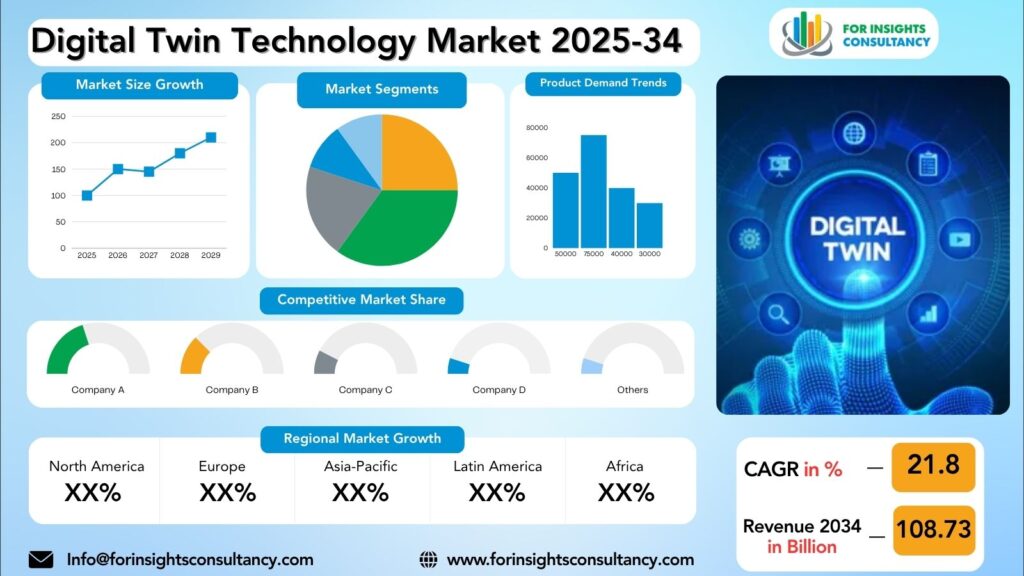
Digital Twin Technology Market Size, Trends Analysis Research Report By Type (Product Digital Twin, Process Digital Twin, System Digital Twin), by Application (Design & Engineering, Manufacturing, Predictive Maintenance, Performance Monitoring, Supply Chain Management), by Deployment Mode, by End-User Industry, and By Region Global Market Analysis And Forecast, 2025-2034
Oct-2025 Formats | PDF | Category: IT | Delivery: 24 to 72 Hours
Global revenue from the Digital Twin Technology market is established at US$ 17.6 Billion in 2025 and has been forthright to current at a CAGR of 21.8% to extent US$ 108.73 Billion by the end of 2034.
Digital Twin Technology Market Research Summary
The global digital twin technology market has experienced a tremendous growth over the years, and the market report provides an exhaustive insight into the existing scenario and the forthcoming changes. A digital twin is a virtual model that represents a physical object, process, or system and is designed to collect, simulate, and analyze real-time data. Digital twins are becoming a popular choice across different industries such as manufacturing, healthcare, and smart cities due to technological advancements in IoT, AI, and cloud computing.
Leading companies in the digital twin technology market are heavily placing their bets on research and development to open up new opportunities for their products and services, such as predictive maintenance, product optimization, and performance monitoring. With the help of these advanced technologies, businesses get the necessary tools and resources to streamline their operations, cut down on costs, and improve their decision-making processes.
By looking into the future of digital twin technology, the pervasion of this technology in the everyday use of other novel technologies such as blockchain and edge computing is certainly a matter of discussion. The result will be a larger number of real-time insights, enhanced security features, and the possibility to scale up digital twin applications. In a nutshell, the digital twin technology market is set to expand considerably as industries move towards more data-driven and interconnected solutions for operational excellence.
Market Insights
- In 2024, the Digital Twin Technology Market is expected to experience significant growth, with the largest regional revenue share projected to come from North America.
- The market forecast indicates a substantial increase in revenue from this region due to the increasing adoption of digital twin technology across various industries.
- Furthermore, by 2024, approximately 85% of the U.S. population is expected to reside in urban areas, highlighting the need for advanced digital solutions to enhance urban infrastructure and sustainability.
- In terms of market segments, the largest revenue share is anticipated to come from the manufacturing sector, driven by the demand for digital twins to optimize production processes and improve operational efficiency.
- Other key segments contributing significantly to the market revenue include healthcare, automotive, and smart cities.
Market Dynamics
Trends
Increased Adoption Across Industries: Digital twin technology is projected to have a massive inflow of usage in a wide variety of the sector, including manufacturing, healthcare, and smart cities.
Focus on Predictive Maintenance: Digital twins will be a tool that enterprises shall utilize more and more on predictive maintenance tasks, which in turn will bring the result of a decrease in the time for a machine to be stopped and an increase in the efficiency of operations.
Integration with IoT and AI: Using digital twin technology together with IoT devices and AI systems will open up new possibilities and features for digital twins.
Rapid Growth in Smart Infrastructure Projects: The expansion of smart infrastructure initiatives will be the source of an upturn in the usage of digital twin technology, which is instrumental in improving the monitoring, management, and optimization of the most vital assets.
Enhanced Data Analytics Capabilities: The evolution of digital twins will lead them to provide more sophisticated data analytics capabilities, thus, allowing enterprises to obtain deeper insights and make a more precise strategic decision.
Growth Drivers
The demand for digital twins in the manufacturing and industrial sectors is being fueled by the increased use of Industry 4.0 practices.
There is a growing recognition of the benefits of digital twin technology in improving operational efficiency and lessening equipment downtime.
The use of IoT and AI technologies with digital twins is one of the methods that helps in predictive maintenance and increases asset performance.
The growing investments in smart infrastructure projects are resulting in the increased usage of digital twins in urban planning and the construction sector.
The focus on remote monitoring and virtual simulations during the COVID-19 pandemic has been one of the reasons for the rapid increase in the adoption of digital twin solutions across different sectors.
Restraints
Data Security Issues: Digital twins are generating massive amounts of data, which means that the risk of unauthorized data access and cyberattacks has drastically increased. Data security and privacy have become major concerns as a result.
Implementation Complexity: The use of digital twins technology is a time-consuming, resource-consuming, and expertise-consuming task, which makes it difficult for some organizations to implement and integrate the technology efficiently.
Absence of Industry Standards: The lack of standardized protocols and frameworks for digital twins in various industries that facilitate interoperability and data sharing is what causes the technology to be less scalable and less widely used.
Expensive Initial Costs: The costs related to the first installation and the launching of the digital twin technology may be quite high, particularly for small and medium-sized enterprises, thereby discouraging some businesses from entering the market.
Opportunities
Increased Adoption in the Manufacturing Sector: Manufacturing will be the major industry to implement digital twin technology mainly to increase their operational efficiency and productivity.
Healthcare Applications to Get Bigger: The use of digital twins is forecasted to be instrumental in the field of medicine tailored to individual patients, remote patient monitoring, and the predictive maintenance of medical devices.
Expansion of Smart Cities Projects: The use of digital twin technology for urban planning, infrastructure management, and energy consumption optimization is a big investment that governments all over the world are likely to make.
Continuation of IoT and AI Integration: The use of Internet of Things (IoT) gadgets and Artificial Intelligence (AI) in combination with digital twins will open up new possibilities for on-the-spot checking and forecasting analytics.
Challenges
Data Security Concerns: The tremendous amount of data arising from digital twins will make data security and privacy the biggest issues that companies in the market will have to face.
Interoperability Issues: Digital twin technology integration with current systems and processes can be a difficult task, thus organizations facing interoperability challenges as a result.
Scalability: The challenge of scaling these technologies to meet the increasing demands will be a major one as digital twin applications spread across various industries.
Skill Gap: The lack of skilled professionals capable of designing, implementing, and maintaining digital twin systems may become a barrier to the market growth in the next few years.
Regulatory Compliance: A large challenge faced by businesses utilizing digital twin technology will be conforming to changing regulations and standards related to data protection.
Digital Twin Technology Market Top Companies Covered In This Report:
Evaluate The Strategic Positioning And Innovation Pipelines Of Leading Market Companies-From Multinational Enterprises To Disruptive Regional Firms. Understand How Key Players Are Innovating, Expanding, And Capturing Value, And Use Competitive Benchmarks To Plan Your Next Move.
- Tibco Software Inc.
- SAP SE
- Microsoft Corporation
- Siemens Ltd.
- General Electric Company
- Forbes India
- Schnitger Corporation
- IBM Corporation
- Hexagon AB
- AVEVA Group plc
- Bosch Software Innovations GmbH
Digital Twin Technology Market Company News 2024 and 2025
Tibco Software
TIBCO Software Inc. announced its next-generation TIBCO® Platform on June 18 2024, a unified composable data platform that strengthens its ability to deliver large-scale digital initiatives and supports digital twin use-cases via enhanced observability, integration and edge-to-cloud capabilities.
Siemens
Siemens revealed at CES 2025 (January 6, 2025) new industrial AI and digital twin innovations via its Xcelerator platform, including immersive engineering and digital twin-driven design/manufacturing solutions.
Key Segments
Segmentation By Type
- Product Digital Twin
- Process Digital Twin
- System Digital Twin
Segmentation By Application
- Design & Engineering
- Manufacturing
- Predictive Maintenance
- Performance Monitoring
- Supply Chain Management
Segmentation By Deployment Mode
- Cloud
- On-Premises
Segmentation By End-User Industry
- Aerospace & Defense
- Automotive & Transportation
- Healthcare
- Energy & Utilities
- Manufacturing
- Retail & Consumer Goods
- Smart Cities
Global Geographic Coverage:
The Report Provides In-Depth Qualitative And Quantitative Data On The Digital Twin Technology Market For All Of The Regions And Countries Listed Below:
North America
Digital Twin Technology market in North America is anticipated to be bullish in the next couple of years owing to the region’s robust GDP growth and low inflation rate. A single government subsidy in the U.S. targeted at companies that adopt digital twin technology has been the main factor for its quick adoption, thus making it a local, non-replicable driver. The leading channel for digital twin technology products in North America is by means of online platforms, whereas the quickest developing channel is through partnerships with technology integrators.
Consumers in North America have become more conscious of the environment and ethical sourcing, thus these have become the main things that companies have to consider if they want to operate in the region. Nevertheless, in numerous emerging markets where price and status are the most influential factors in consumer preferences, companies might have to find a way to offer affordable products while also implementing sustainable practices to attract a broader customer base.
Europe
The European Digital Twin Technology Market will be majorly impacted by a GDP Growth of 5% and an Inflation Rate of 2%. One of the main factors that Germany becomes an attractive zone for the digital twin technology is the presence of government subsidies that are specifically directed to digital innovation. In France, the main channel is through partnership with the established industrial players, whereas Sweden is witnessing the fastest growth through direct-to-consumer sales. Throughout Europe, consumers are very much concerned about the environment and the ethical sourcing of the products, which has become a necessity for product adoption. On the other hand, in the case of markets that are still emerging such as Romania and Bulgaria, price and status are the factors that determine consumer preferences the most, thus, posing a unique challenge for market penetration. The European Digital Twin Technology Market will be here with us for a long time as it keeps on changing and spreading over its different sub-regions.
Asia Pacific
With a projected GDP growth of 5% and an inflation rate of 2%, the Asia Pacific Digital Twin Technology Market is set to grow substantially. A government subsidy for the adoption of digital twin technology in the manufacturing industries is the main local driver in Japan that is influencing the market. The industry partnerships are the main channel for the digital twin technology adoption, whereas the direct-to-consumer sales in South Korea is the fastest-growing channel.
Consumer in Australia requires that products be sustainable and ethically sourced, which is driving the demand for digital twin technology in eco-friendly urban planning projects. In situations such as India and Indonesia, where the price and status are of utmost importance, localism is playing a very significant role in the decision of purchasing consumers, who prefer digital twin solutions tailored to the local needs and tastes.
Middle East and Africa
The Digital Twin Technology market in the Middle East and Africa (MEA) as well as its sub-regions is influenced by different sets of the unique dynamics. The GDP growth forecast and the inflation rate in the MEA region point to a sizeable opening for new technologies.
In South Africa, the market for digital twin technology has been on the rise due to the introduction of a specific government subsidy. In Egypt, the main channel for digital twin technology is through the collaboration with local tech companies, whereas in Nigeria, the direct online sales are the fastest-growing channel.
Consumers in the MEA region are highly concerned about the environment and the ethical sourcing of products, which they consider essential. Nevertheless, in the case of such markets as Kenya and Uganda, the price and status are still the leading factors in consumer decisions, which creates difficulties for companies that only concentrate on sustainability.
Frequently Asking Questions
What is the Digital Twin Technology market size and growth forecast?
Digital Twin Technology Market is predicted to grow from USD 17.6 Billion in 2025 to approximately USD 108.73 Billion by 2034. the industry is estimated to expand at a CAGR of 21.8%.
Who are the key players in the Digital Twin Technology market?
The Digital Twin Technology Market Includes Major Companies Tibco Software Inc., SAP SE, Microsoft Corporation, Siemens Ltd., General Electric Company, Forbes India, Schnitger Corporation, IBM Corporation, Hexagon AB, AVEVA Group plc, Bosch Software Innovations GmbH, Others.
What are the current and future trends for Digital Twin Technology market?
Current trend: Increased adoption of digital twin technology across various industries such as manufacturing, healthcare and construction for real-time monitoring and predictive maintenance.
Future trend: Integration of artificial intelligence and machine learning algorithms to enhance the capabilities of digital twins for advanced analytics and decision-making.
What are the challenges facing the Digital Twin Technology market?
Challenges facing the Digital Twin Technology Market include data privacy concerns due to the sensitive nature of interconnected data, and the high costs associated with implementing and maintaining digital twin systems. Additionally, interoperability issues between different platforms and systems pose a challenge for widespread adoption.
Which regions dominate the Digital Twin Technology market?
North America dominates the Digital Twin Technology market, followed by Europe and the rapidly growing Asia-Pacific region.
Report Features
This report gives the most complete information. The report on Digital Twin Technology Market format has been designed so that it can provide the best value to the business. It offers crucial insights into the market’s dynamic and will aid in strategic decision-making for current players as well as those looking to join the market.
What Deliverables Will You Get in this Report?
|
Key questions this report answers |
Relevant contents in the report |
|
How big is the sales opportunity? |
In-depth analysis of the Global Digital Twin
Technology Market |
|
How lucrative is the future? |
Market forecast and trend data and emerging
trends |
|
Which regions offer the best sales opportunities? |
Global, regional and country level historical
data and forecasts |
|
Which are the most attractive Digital Twin
Technology market Key segments? |
Market segment analysis and |
|
Which are the top Key players and Their Digital
Twin Technology market positioning? |
Competitive landscape analysis, Market share
analysis |
|
How complex is the business environment? |
Porter’s five forces analysis, PEST analysis,
Life cycle analysis |
|
What are the factors affecting the Digital Twin
Technology market? |
Drivers & Restraints |
|
Will I get the information on my |
Customized Report as per your Business
Needs Our analysts will work directly with you and
understand your needs Get data on specified regions or segments,
competitor and Vendors Data will be formatted and presented as per your
requirements Any Requirement Contact Us: Https://Www.Forinsightsconsultancy.Com/Contact-Us |
Table of Contents
For TOC Contact us: https://forinsightsconsultancy.com/contact-us/






